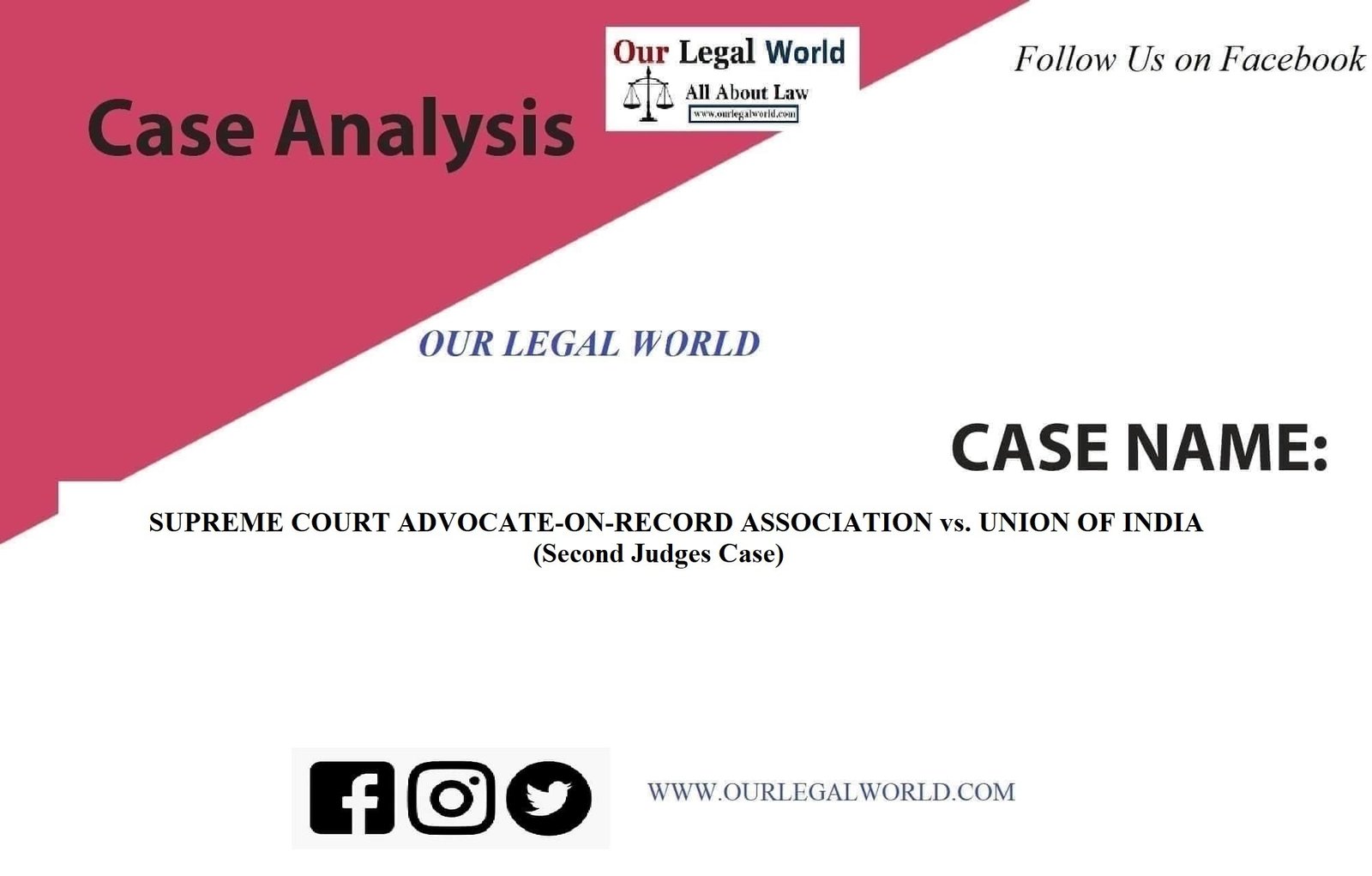Second Judges Case: SUPREME COURT ADVOCATE-ON-RECORD ASSOCIATION vs. UNION OF INDIA
In the Supreme Court of India
Civil Original Jurisdiction
Case No.: Writ Petition (Civil) no. 13 of 2015
Petitioner: Supreme Court Advocates on Record Association
Respondent: Union of India
Bench :Justice Jagdish Singh Khehar, Justice Chelameswar, Justice Madan B. Lokur, Justice Kurian Joseph, Justice Adarsh Kumar Goel
Introduction
Whenever we study about Supreme Court, we often bump into the words like collegium system of Supreme Court. This system is nothing but a principle tenet of judiciary of India. In order to understand its importance and need one has to understand the process of appointment of judges in SC and HC.
Collegium system was devised by the Supreme Court of India. It is not mentioned in the Constitution. It is given birth by the hon’ble SC through its judgments given over a few cases on the serious threat to independence of judiciary in 1970 when many judges were superseded in the appointment of CJI and various attempts were made to effectuate transfer of many HC judges
For a better understanding one has to look into the second judges’ case along with the Judges’ Transfer case (S. P. Gupta v. Union of India – 1982) and In re Special Reference 1 of 1998. These cases revolve around the question whether independence of judiciary is included in the basic structure of Indian Constitution or not and power to appoint judicial officers lies in whose hand.
Background
In order to know the roots of the contentions decided in the second judges’ case we need to look into the initiation of the debate which was talked upon in the case of S. P. Gupta v. Union of India, 1982.
The then union law minister issued a circular to state chief ministers (i) asking the future judicial appointees and additional judges for the agreement to be appointed as judges of high court of other states (ii) including chief justice of states and (iii)appointment of additional judges despite having vacancies in permanent posts. (iv)refusal to reappoint the additional judges (v) extending the period of additional judge to 3 months only.
PILs and Writ Petitions were filed in the Supreme Court against this circular in which the relief sought by the plaintiff was – (i) the circular or declaration issued by union law minister to be declared unconstitutional (ii) the renewal of appointment of additional judge to be ordered (iii) transfer of chief justice from one HC to another HC to be declared unconstitutional.
The judgment given in the judges’ transfer case in a way decided nothing significant that petitioners demanded for. It gave ruling in favour of the executive, giving it the driver’s seat in the judicial appointment process, giving the CJI or Chief Justice of any High Court only consultative role. The Supreme Court with 4:3 majority decided that the word consultation in Article 124(2) and in Article 217(1) does not imply concurrence.
Second Judges’ case-
Facts
In 1993 while hearing cases on vacancies of post of judges the question of independency of judicial appointments came for reconsideration before the hon’ble Supreme Court in the case of Subhash Sharma v. Union of India (1991 Supp (1) SCC 574). This case had a 3 judge bench who were of opinion that the majority view of the judges in the case of S. P. Gupta v. Union of India, 1982 should be considered by a larger bench. Therefore a nine judge bench was formed for the purpose of examining the previous case judgment.
Issues
Whether the opinion of Chief Justice of India should be given primacy with regard to the appointment and selection of Judges of High Courts and the Supreme Court, as well as in the transfer of Judges from one High Court to other?
The world “consultation” in article 124 is interpreted in a way indicating full discharge of constitutional obligations on the part of constitutional functionaries.
In case of transfer of judges, transferee’s consent is irrelevant. Although the transfer must not be in punitive in nature, this point is in conformity with the decision given in SP Gupta case. Also personal factors must also be kept in mind while affecting a transfer.
Whether this matter, as well as that of fixation of the number of Judges of each High Court, is justifiable?
Putting a limit to the number of judges is justifiable but this strength suggest lack of speedy justice (speedy justice as mandated by article 21 of the constitution), also the opinion of the Chief Justice of India and the Chief Justice of respective High Court must be taken into account.
Held–
A nine judge bench overruled the decision given in S. P. Gupta case and gave primacy to CJI over president on appointment of judges and transfer matters. It also said that the word consultation would not lessen the primary role of CJI in judicial appointments.
This case also provided judiciary with a specific procedure called collegium systemfor the purpose of appointment and transfer of judges to higher judiciary. The collegium consisted of CJI and two senior most judges of SC apart from CJI in case of appointment of SC judges. The collegian consisted of CJI and two senior most HC judges after CJI for appointment of HC judges.
Finally, in the Third Judges Case (In re Special Reference 1 of 1998) the SC reaffirmed its judgment given in 1993 and expanded the Collegium to include the CJI and the four most-senior judges of the court after the CJI.
Judicial Interpretation
The judgment given in the second judges’ case was a landmark case as it gave assured independence to judiciary and in this effect gave primacy to CJI. This was done to protect the integrity of judiciary.
Despite the case being a landmark one, there has been several criticism of the judgment given in the second judges’ cases:
- As there is no official mechanism or secretariat for the functioning of collegium system, it is not a transparent system. It is considered as a concealed and undisclosed affair with no prescribed rules and regulations regarding the selection procedure.
- Also there is no transparency as to when and where the collegium meets and makes the decision regarding appointment i.e. no public notice regarding the same. Even advocates do not know whether their name has been considered for their promotion as judge or not.
Efforts made to address the above mentioned concerns
Justice M N Venkatachaliah Commission was established by the government of 1998-2003 to give suggestion as to need of change in collegium system.
The commission favoured change and recommended National Judicial Appointment Commission (NJAC), which consisted of the CJI and two senior most judges, the Law Minister, and an eminent person from the public, elected by the President in consultation with the CJI.
The NDA government passed NJAC Bill in 2014 as the 99th constitutional amendment and made it a law which later in 2015 was declared to be unconstitutional by a constitutional bench with a 4:1 majority judgment which upheld the collegium system and primacy of CJI.
Conclusion
The judiciary stands between the citizens of India and the government as a bridge solving the problems of society and the state. Therefore it has to be kept separate from the legislature and the executive. There are very few judges who criticise the collegium system. Justice J Chelameswar stated that “proceedings of the collegium were absolutely opaque and inaccessible both to public and history, barring occasional leaks”.
In my opinion lack of transparency has given space for nepotism to grow and elevation of judges on the basis of seniority and merits are no longer guaranteed. But at the same time the other alternative i.e. NJAC was a direct infringement of judicial independence and violation of separation of powers and maybe that’s the reason collegium system was preserved and continues to be in place.
References
Also Read:







